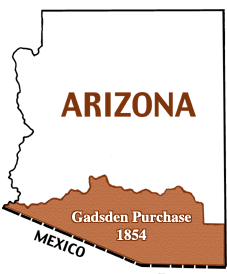


The children who created the Little Cowpuncher were from families who worked in ranching or mining operations in Southern Arizona. Most of them were Mexican or Mexican-American. Some were the sons and daughters of pioneer ranching families. A few could trace their holdings back to Spanish Colonial or Mexican era land grants. Others were newer immigrants, whose fathers were vaqueros working on the large ranches in the area. Some, like their teacher Eulalia Bourne, were holding down homestead claims. Here is a simplified background history of the area where they lived:
The Prehistoric Farmers
As early as around 8,000 B.C. people were living in what is now Southern
Arizona. They farmed and hunted an area that was completely different
from the desert that exists today. The temperature was 30 degrees cooler
then, almost four times wetter, and there was lush vegetation. Gradually
the climate grew warmer and drier, finally becoming a desert. The prehistoric
Hohokam, who lived in the area from around 700 to 1300 A.D. were the first
desert farmers. They built irrigation canals along the rivers and grew
corn, beans and squash.
The Spanish Missionaries
When the first Spanish missionaries arrived in the late 1600's, the
area was populated by Pima Indian tribes. Hoping to convert them to Christianity,
the Jesuit missionary, Father Eusebio Francisco Kino, established a system
of visitas (mission stations) in the region. He brought in herds of cattle,
horses, sheep and goats. He introduced abobe construction and started
the cultivation of a wide variety of European food plants. It was the
beginning of ranching in the area.
The Apache Threat
The civil authorities of New Spain established precidios (garrisons),
surrounded by Spanish settlements, but all attempts at development were
seriously impacted by the raiding nomadic Apaches. The Spanish authorities
tried a number of tactics to deal with the situation. Most of these plans
were military, but they also awarded land grants to encourage settlement
in the area. Nothing, however, provided a permanent solution for the "Apache
Problem."
Mexican Independence
September 16, 1822, Mexico gained its independence from Spain. During
the short period of Mexican rule, land grants were again issued in the
region, mostly along the Santa Cruz and San Pedro Rivers. Apache raids,
however, continued to make it all but impossible to settle the land, and
many of the claims were abandoned. Early in the Mexican Era, the first
Americans arrived. They were hunters, who were followed in the early 1830's
by cattle and mule drivers. During the Gold Rush some 50,000 people passed
through the area on their way to the gold fields in California. Some of
them returned. Many of these settlers married Mexican women and stayed
in the area.
 |
The Gadsden Purchase |
The Railroad
The completion of the railroad in 1880 brought enormous changes to the
new Arizona Territory. The easy transportation of American goods and supplies
made it difficult for many Mexican-American businessmen to compete. Wealthy American entrepreneurs began streaming into the Territory. They invested in, and
soon dominated, mining, ranching, retailing and agriculture. Many families
that had farmed along the Santa Cruz River for four generations lost their
fields to land speculators. The flow of the river was changed, and traditional
Mexican American agriculture began to disappear. Many of the families
moved into town.
Farming, Ranching and Mining
Old mining claims at places like Arivaca, Sopori, and Helvetia were reactivated,
and deserted ranches were given a new life as new European Americans took
over abandoned claims. In 1910 the Mexican Revolution brought a wave of
Mexican migrants into Arizona Territory. They came to work with farming,
ranching, and mining. Some returned to Mexico, but many settled and stayed.
It was a time of peace and prosperity for the region, with ranching and
farming providing the backbone of the economy. February 14, 1912, Arizona
became the 48th state. Ranching continued to be a vital part of Southern
Arizona's economy for many years.
Southern Arizona Today
Today cattle ranching is a controversial subject, and its importance to
the economy is greatly diminished. Developers are buying up land where
ranches and ranching communities once flourished, building planned communities
and golf courses. Fewer and fewer working family ranches are left in Southern
Arizona. In spite of these developments, ranching remains an important part of the cultural
history, and Spanish, the language established 300 years ago in the area,
is still spoken by about a quarter of the population.
